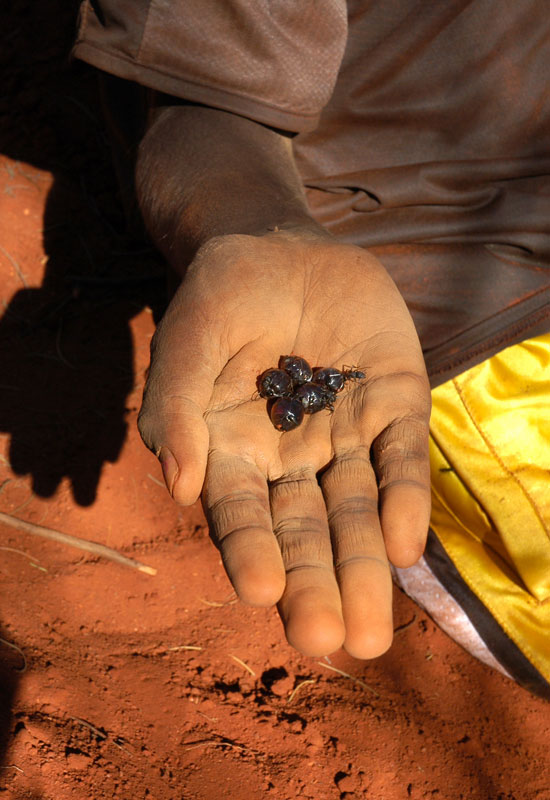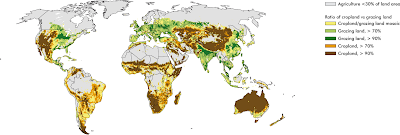When I think of ants, my automatic reaction is
annoyance. I envision the common
scenario in many college student homes: you left that half-finished bowl of Cookie
Crisp out one day too long, or did not wipe up that juice you spilled on the
counter while using it for a chaser in a timely fashion. Before long, you have
tiny invaders all over your kitchen, and their numbers seem endless. Although these ants are a frequent source of
frustration for many of us, it is time we gave ants some credit for actually
helping us out instead of blaming them for attacking our forgotten sandwich crusts.
We as humans benefit directly from many processes in nature
in a variety of ways. This concept has been dubbed ‘ecosystem services’, and
can cover a range of activities from
carbon sequestration to pharmaceutical production to ecotourism. Ecosystem services have been divided into
four main categories: provisioning, supporting, regulating, and cultural. These services have a direct effect on human
well-being, allowing us to live somewhat spoiled lives because nature takes
care of so many things for us automatically and without a monetary cost.
Imagine if we had to pay bacteria for nutrient cycling? Ecosystem services are
essential to our lives as we know it, and yet many go unnoticed and
unappreciated by the majority of the planet’s human population. Well, it is
time for ants to go unappreciated no longer. They provide the human species with
a service in each of the four categories of ecological services, and deserve
some positive attention for once. Ants aren't often credited with playing a role in maintaining our well-being, but I will show you how they contribute in every single aspect of the intertwined chart between nature and humans shown above.
One of the most important services provided by ants is their
role in agriculture. This falls in the category of a supporting service. In
2011, Evans et al provided
a research
article that credited ants (as well as termites) with increasing wheat crop
yields by 36% in dry, arid climates. This is an important service for farmers
because it is a way to be more efficient without investing more money. It also
allows crops to grow in areas where they can just as easily fail. The ‘green
revolution’ is the term coined for the intensification of agricultural
productivity in the last century. We can see that crop yields have definitely
increased, but often those results are due to herbicides and other potentially
harmful agents, or the use of excessive amounts of water. Ants however, allow
for the crop yield to rise in a sustainable way – which is good for everyone
involved. It provides a service to humans, while also helping to maintain
biodiversity in these agricultural areas that normally are detrimental to
biodiversity levels . Ants accomplish this amazing feat by just doing what they
normally do, building tunnels in the ground. As the ants build their colonies
under these dry, arid grounds, they allow for increased water infiltration and
increase the amount of nitrogen in the soil. These factors allow the wheat more
of the sustenance it needs to grow, and for free!And
if contributing to the growth of wheat just isn’t enough, ants have also been
shown to be key in agroecosystems that specialize in the production of coffee,
chocolate, and wine (Chong et al 2011
and Philpott et al 2006). As it
happens, those are three of my absolute favorite things in the world, so I have
to give props to ants for acting as predators in these agroecosystems and
protecting these much loved products from disease so they can be available for
my consumption. The ants present in these ecosystems act as biological control
agents, protecting the plants from insect pests and fungal pathogens, which
allows for increased plant growth and reproduction. Thank you, ants.
. Ants accomplish this amazing feat by just doing what they
normally do, building tunnels in the ground. As the ants build their colonies
under these dry, arid grounds, they allow for increased water infiltration and
increase the amount of nitrogen in the soil. These factors allow the wheat more
of the sustenance it needs to grow, and for free!And
if contributing to the growth of wheat just isn’t enough, ants have also been
shown to be key in agroecosystems that specialize in the production of coffee,
chocolate, and wine (Chong et al 2011
and Philpott et al 2006). As it
happens, those are three of my absolute favorite things in the world, so I have
to give props to ants for acting as predators in these agroecosystems and
protecting these much loved products from disease so they can be available for
my consumption. The ants present in these ecosystems act as biological control
agents, protecting the plants from insect pests and fungal pathogens, which
allows for increased plant growth and reproduction. Thank you, ants.
 . Ants accomplish this amazing feat by just doing what they
normally do, building tunnels in the ground. As the ants build their colonies
under these dry, arid grounds, they allow for increased water infiltration and
increase the amount of nitrogen in the soil. These factors allow the wheat more
of the sustenance it needs to grow, and for free!And
if contributing to the growth of wheat just isn’t enough, ants have also been
shown to be key in agroecosystems that specialize in the production of coffee,
chocolate, and wine (Chong et al 2011
and Philpott et al 2006). As it
happens, those are three of my absolute favorite things in the world, so I have
to give props to ants for acting as predators in these agroecosystems and
protecting these much loved products from disease so they can be available for
my consumption. The ants present in these ecosystems act as biological control
agents, protecting the plants from insect pests and fungal pathogens, which
allows for increased plant growth and reproduction. Thank you, ants.
. Ants accomplish this amazing feat by just doing what they
normally do, building tunnels in the ground. As the ants build their colonies
under these dry, arid grounds, they allow for increased water infiltration and
increase the amount of nitrogen in the soil. These factors allow the wheat more
of the sustenance it needs to grow, and for free!And
if contributing to the growth of wheat just isn’t enough, ants have also been
shown to be key in agroecosystems that specialize in the production of coffee,
chocolate, and wine (Chong et al 2011
and Philpott et al 2006). As it
happens, those are three of my absolute favorite things in the world, so I have
to give props to ants for acting as predators in these agroecosystems and
protecting these much loved products from disease so they can be available for
my consumption. The ants present in these ecosystems act as biological control
agents, protecting the plants from insect pests and fungal pathogens, which
allows for increased plant growth and reproduction. Thank you, ants. |
| Honey Ants eaten in Central OZ |
An unexpected area of contribution that ants play a role in
is the ‘provisioning’ category of ecosystem services. It may surprise you that
according to Neelkamal Rastogi, ants are an “unconventional human food source”
(2011). In some areas of Southeast Asia, China, South and Central America,
Africa, and Australia, ants are a significant source of protein for many
indigenous people. There are several species that are edible in both the adult
and larvae stage of life, and in some tribes ants are prepared in such a way
that they are considered a delicacy. My personal favorite method of ant
consumption is mashing them up and mixing them into water to make a “pleasant
sour drink”, as is done by Queensland, Australia natives (Rastogi 2011). Mmmmm…protein.
Another important ecosystem service provided by ants is in
the regulation category. One might not often think of ants right off the bat
when ‘disease prevention’ is mentioned, but those pesky little buggers have
some tricks up their sleeve. Like using
ants as a source of nutritional protein, many native peoples across the world
also traditionally used ants to treat a wide variety of diseases and
afflictions. In Africa, the mandibles of
some ants were used as sutures. In India, another species was ground up and
used to treat gout and joint pain. Yes, these are not the methods we use in
Western medicine, but ants have also become an important source for
pharmaceuticals, namely antibiotics because of their well-developed immune
systems and ability to resist disease (Rastogi 2011). Pharmacological companies
are continuing to investigate ants as a source of treatment to diseases such as
arthritis and asthma. One more ecological service, brought to you courtesy of
ants.
 | |||
| Ants are Awesome |
And last but certainly not least, ants provide us with
ecosystem services in the cultural category. Nature has many ways of
contributing to our cultural growth and sustenance as humans, ranging from
spiritual to aesthetic methods of service. I know some of you may feel that
ants often provide a recreational disservice by invading your picnics, but let’s
not forget that they contribute to the most essential human cultural service:
education. Who doesn’t love watching Planet Earth, getting sucked in to the
amazing footage of polar bear cubs and tiny baby sea horses. Well, ants can be
pretty amazing too, and if (like me) you love dropping random facts you learn
from nerdy TV shows on your friends, then this BBC video on army ants will
provide a great cultural ecosystem service to you. Enjoy.
Citations:
Chong, C., L. Thompson, A. Hoffman. (2011) High diversity of
ants in australian vineyards. Australian Journal of Entomolgy 50(1):
7-21.
Evans, T., T. Dawes, P. Ward, N. Lo. (2011) Ants and
termites increase crop yield in a dry climate. Nature Communications
2: 262.
Philpott, S., Armbrecht, I. (2006) Biodiversity in tropical
agroforests and the ecological role of ants and
ant diversity in predatory function. Ecological
Entomology 31(4): 369-377.
Rastogi, N. (2011) Provisioning services from ants: food and
pharmaceuticals. Asian Myrmecology 4: 103-120.
Sanford, M., P. Manley, D. Murphy. (2009) Effects on urban
development on ant communities: implications
for ecosystem services and management. Conservation
Biology 23(1): 131- 141.












